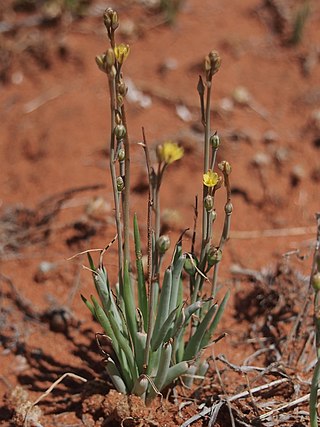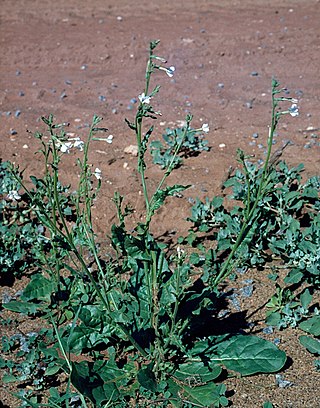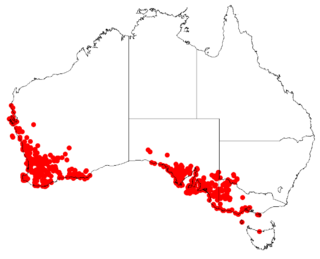
Zygophyllaceae is a family of flowering plants that contains the bean-caper and caltrop. The family includes around 285 species in 22 genera.

Fagonia is a genus of wild, flowering plants in the caltrop family, Zygophyllaceae, having about 34 species. The latest reorganization of the genus took place in 2021 when systematists Christenhusz & Byng included Fagonia spp.. along with several other Zygophyllum genera, into a new genus named "Zygophyllum L." Species occurring in the US are commonly referred to as fagonbushes. The distribution of the genus includes parts of Africa, the Mediterranean Basin, the Mid-East, India, and parts of the Americas. Fagonia species have been used ethnobotanically by traditional practitioners under Ayurvedic and other TM healing regimes for many maladies. Species occur in deserts, dry washes, ditches and on rocky outcrops, including at altitude.

Zygophyllum is the type genus of the flowering plant family Zygophyllaceae. The generic name is derived from the Greek words ζυγόν (zygon), meaning "double", and φυλλον (phyllon), meaning "leaf". It refers to the leaves, each of which have two leaflets.

Malva parviflora is an annual or perennial herb that is native to Northern Africa, Europe and Asia and is widely naturalised elsewhere. Common names include cheeseweed, cheeseweed mallow, Egyptian mallow, least mallow, little mallow, mallow, marshmallow, small-flowered mallow, small-flowered marshmallow and smallflower mallow. M. parviflora leaf extracts possess anti-inflammatory and antioxidant activities. It has a decumbent or erect habit, growing up to 50 cm in height. The broad leaves have 5 to 7 lobes and are 8 to 10 cm in diameter. It has small white or pink flowers with 4 to 6 mm long petals.

Thysanotus patersonii, the twining fringe-lily, is a climbing perennial herb which is endemic to Australia.
Crassula colorata, the dense pigmyweed or dense stonecrop, is an annual plant in the family Crassulaceae. The species is endemic to Australia, occurring in Western Australia, South Australia, New South Wales and Victoria.

Bulbine semibarbata, commonly known as leek lily, native leek or wild onion, is a species of annual herb native to Australia.

Nicotiana occidentalis, commonly known as native tobacco, is a short-lived herb native to Australia.

Erodium cygnorum is a species of herb native to Australia.

Podotheca angustifolia, commonly known as sticky longheads, is a species of herb native to Australia.
Roepera billardierei, synonym Zygophyllum billardierei, commonly known as coast twin-leaf, is a species of plant in the family Zygophyllaceae found in temperate regions of Australia. In Tasmania, where it has only been recorded from the Furneaux Group in Bass Strait, it is listed as Rare under the state's Threatened Species Protection Act 1995.
Tetraena qatarensis is a salt-tolerant dwarf shrub that grows in the Arabian Peninsula. It has small compact leaves that store water. The leaflets grow in pairs and the flowers have four or five petals.

Tetraena fontanesii, synonym Zygophyllum fontanesii, is a species of plant of the family Zygophyllaceae. It is found in Macaronesia and northwest Africa.

Tetraena is a genus of flowering plants in the family Zygophyllaceae.

Roepera is a genus of flowering plant in the family Zygophyllaceae. It is native to southern Africa and Australia.

Actinobole uliginosum, the flannel cudweed, is a species of dwarf annual herb in the family Asteraceae, which is endemic to Australia. It occurs in every state of mainland Australia.

Trachymene ornata, or spongefruit, is a slender annual herb in the family Araliaceae. It is native to Australia and found in Western Australia, South Australia and New South Wales.

Tetraena simplex, commonly known as hureim or simple-leaved bean caper, is a halophytic flowering plant that is distributed in arid regions of the Western Asia and Africa. It is an annual and has a history of being used in Arabic folk medicine as an anti-inflammatory.

Roepera morgsana is a succulent plant species in the genus Roepera. It is endemic to Namibia and the Cape Provinces of South Africa.















